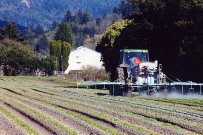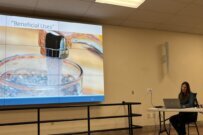State and federal regulators charged with protecting public trust values — such as clean air and water, healthy wildlife, and human health — are apparently uninterested in enforcing laws that should protect the estuary.
It was in spring of 2014 that Siskiyou Land Conservancy obtained the clearest evidence that pesticides are indeed poisoning one of the most biologically important estuaries on the West Coast of the United States. That was when the North Coast Regional Water Quality Control Board released a devastating report revealing that in 2013 its scientists had uncovered “acute (and) chronic reproductive toxicity” in three of the four streams that feed the Smith River estuary. This means that invertebrates that make up the basis of the salmonid food chain not only cannot reproduce in these water (“chronic toxicity”), but that they cannot even survive in it (“acute toxicity”).
The Water Board’s findings indicate that the entire food chain of the Smith River estuary may be threatened. What is causing this toxicity? In Del Norte County, in the far northwestern reach of California, farmers who grow virtually all of the U.S. production of Easter lily bulbs apply an annual average of 300,000 pounds of highly toxic pesticides on some 1,000 acres of lily fields that drain directly to the Smith River estuary. Several pesticides used on Easter lily fields can cause reproductive toxicity.
The 2013 testing occurred three years after the Water Board found that Delilah Creek, a stream feeding Tillas Slough (the Smith River estuary’s only remaining large, functional slough) was contaminated with pesticide residues, namely copper at levels that were 28 times higher than that allowed by state law. (In 2013 the Water Board also discovered ten pesticides in Smith River estuary surface waters, seven of which are or have been used on Easter lily fields. Both testing events occurred due to pressure from Siskiyou Land Conservancy.) Lily growers apply more than 40,000 pounds of Class I (most toxic) copper products annually. Copper is deadly to aquatic species. The Water Board also found chronic reproductive toxicity in Delilah Creek in 2010. While the Smith River estuary overall provides critical habitat for endangered salmonids, Tillas Slough marks the northernmost habitat for the tidewater goby, listed as “Endangered” under the federal Endangered Species Act.
Christopher Pincetich, Ph.D., an expert on the effects of pesticides on aquatic organisms, said of the state’s Smith River testing, “The toxicity result is very significant; I saw almost zero reproduction. That test uses Ceriodaphnia dubia, a freshwater invertebrate, the ‘water flea.’ It is very relevant to use as it is the base of the food-web. If Cerio can not reproduce in your watershed, you can technically extrapolate this to say that salmon habitat is likely impaired as their food source (small aquatic invertebrates) is impacted.”

The four circles represent where, in 2013, the state water board found toxicity in streams feeding the smith river estuary. The glowing circle is at the mouth of Rowdy Creek, where state scientists discovered “acute reproductive toxicity,” the highest level of toxicity found in the estuary. Rowdy Creek is one of the Smith River’s two most important spawning streams for endangered coho salmon.
“Impaired” is a technical term under the federal Clean Water Act, meaning that some aspect of the stream is significantly unhealthy. For the Smith River, one of the cleanest and wildest rivers in the world, to quality for such a listing is unheard of.
These tiny testing events, with their devastating result, have forced public trust agencies, lily growers, and NGOs to address the issue of pesticide contamination at the estuary of California’s wildest river. The Smith River is considered a “seed bank” of wild salmonid stocks that, in terms of species recovery, can recolonize salmon and steelhead streams up and down the California-Oregon coast. The Smith is a last holdout in a state riddled with damaged watersheds. But will pesticides prove to be the Smith’s undoing?
Estuaries provide critical habitat for salmonids — particularly, in California, endangered coho salmon — and other species. Protecting the Smith River, in the northwestern corner of California, serves all Californians, and Americans. Superlatives describing the Smith River are inexhaustible and in no way overstated. The watershed is unique among coastal rivers in the United States.
- The Smith River is the wildest and cleanest river in the country outside of Alaska — indeed, it is one of the cleanest rivers in the world.
- The Smith is the only major undammed river in California, and it anchors the coastal heart of the Klamath-Siskiyou Bioregion, one of the oldest, largest and wildest temperate ecosystems in North America.
- The Smith River contains more stream miles federally designated “Wild and Scenic” than any other river in the United States.
- Smith River salmon and steelhead runs are legendary. Some of the largest Chinook salmon (greater than eighty pounds) have been found on the Smith, and the Smith holds the state record for the largest steelhead ever caught (27 pounds).
Nonetheless, a 2002 study commissioned by the Smith River Project (which merged with Siskiyou Land Conservancy in 2004) revealed that in 2000 lily growers applied more pounds per acre of metam sodium and 1,3-Dichloropropene (highly toxic and carcinogenic fumigants, both of them deadly to fish) than occurred in any other county in California. In 2010 Siskiyou Land Conservancy discovered that use of both of these chemicals in Smith River had more than doubled. In addition, use of at least four pesticides along the Smith River estuary exceed the federal government’s established level of concern for endangered aquatic organisms. Seven of the most toxic pesticides are known carcinogens, and many are harmful or fatal to aquatic life. This is an extreme application of chemicals well known to be dangerous to wildlife — particularly fish — alongside what is arguably one of the most biologically critical estuarine habitats on the West Coast of the United States.
In 2012 the National Marine Fisheries Service released its long awaited Southern Oregon/Northern California Coast Coho Salmon Recovery Plan, which lists pesticide use on lily bulb farms alongside the Smith River estuary as one of the greatest threats to salmon in the watershed. The Recovery Plan cites the work of Siskiyou Land Conservancy and its predecessor, the Smith River Project, owing to our original research on pesticide use along the Smith River and its potential impacts on salmonids. Coho salmon are at risk of extinction in California, and the Smith River is considered one of the few streams in the state that sustains viable Coho populations. Nonetheless, the Coho Recovery Plan notes that the Smith River Coho population is at a “high extinction risk.”
Siskiyou Land Conservancy exists in part to protect farmers and farmlands. Yet we cannot abide by the poisoning of one of the most important estuarine habitats on the West Coast of the United States simply to produce an ornamental crop — a commodity that earns Del Norte County far less revenue than do the commercial and sport fishing industries. Yet even these industries are potentially threatened by pesticides. We urge state and federal regulators to show much greater interest in protecting the Smith River estuary from pesticides. Even after significant findings of pesticide contamination there has been no enforcement of the federal Clean Water Act. Siskiyou Land Conservancy will continue to pressure regulators to enforce the law, and we will encourage consumers to purchase only “salmon safe,” organically grown Easter lily bulbs.




The North Coast Regional Water Quality Control Board has not released a 2014 report regarding toxicity in the Smith River estuary.
As I have worked in Smith River almost 15 yrs, why are the levels of copper in the Smith River Community Service District acceptable for human consumption. It has been deemed highly corrosive to plumbing. I’ve witnessed them spray crops in high winds and figured it must be cheap or they wouldn’t waste it that way. When they spray “copper” my nose, mouth and eyes burn. I believe the water quality control board should certainly be looking at this instead of looking the other way. A lot of great and kind people live in Smith River and they deserve protection, too.
Hi Greg, Will you please circulate a petition to draw attention to this travesty, and we can all circulate to our list serves, and other media. Plus there is a lawsuit going on regarding the Caltrans plans to harm many old growth to widen the road for the largest STAA Trucks to barrel on through (199/197). As you know, that road project is on stop order injunction from the courts, giving time to be proving this Caltrans project will unacceptable environmental damage.
The Caltrans widening project, the toxins from Lily farms being allowed to continue to harm the Smith River, and other hazards are accumulated intended harm. Stop the Lily Farmers or move them inland to a reservation.
This is accumulated harm to the Smith River and we all need to join together and take drastic action. It is time to bring the court systems into this tragic disregard for the protected Smith River. Tears are flowing. Where are the Native American Tribes? They must be outraged. All of us must have a leader to lead us to act on this NOW. Thanks for all you do, Trisha SaveRichardsonGrove&SmithRiverForever
Time for legal action…
what can I do? this is so unbelievably sad and real ….my heart and my mind …
Thank you Andrea. See the newest post on this site.
Is there a petition we can sign in order to take action against these lilly farms/pesticide applications? It’s Rachel Carsen’s “Silent Spring” all over again (continuing, actually)!
Thank you Jenny. See the newest post on this site.
The lily growers should start adding biochar to their soil. Biochar itself can help control fungal diseases by supporting beneficial fungi that outcompete pathogens. Biochar will also sorb the copper and prevent it from leaching into the estuary.
Liars got to lie. Greg has been lying about this subject for a decade.
Hi Rick, thanks for chiming in. Please list the lies, we’d love to know what they are. But until you provide specifics you are not believable. Everything we have posted is the result of diligent research, nothing is inaccurate. We’re surprised that you, a commercial salmon fisherman living in Crescent City, would carry water like this for the lily growers, who represent the greatest threat to Smith River salmon and steelhead populations. Don’t let antiquated ideology get in the way of doing the right thing. You should be supporting us.
can the Lily growers be stopped?